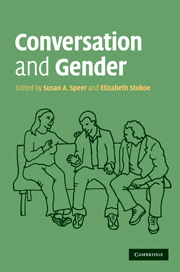Book contents
- Frontmatter
- Contents
- Contributors
- Data and transcription
- 1 An introduction to conversation and gender
- Part I Gender, person reference and self-categorization
- Part II Gender, repair and recipient design
- Part III Gender and action formation
- 8 On the role of reported, third party compliments in passing as a ‘real’ woman
- 9 ‘D'you understand that honey?’: Gender and participation in conversation
- 10 Bids and responses to intimacy as ‘gendered’ enactments
- Part IV Gender identities and membership categorization practices
- References
- Author index
- Subject index
9 - ‘D'you understand that honey?’: Gender and participation in conversation
Published online by Cambridge University Press: 05 June 2012
- Frontmatter
- Contents
- Contributors
- Data and transcription
- 1 An introduction to conversation and gender
- Part I Gender, person reference and self-categorization
- Part II Gender, repair and recipient design
- Part III Gender and action formation
- 8 On the role of reported, third party compliments in passing as a ‘real’ woman
- 9 ‘D'you understand that honey?’: Gender and participation in conversation
- 10 Bids and responses to intimacy as ‘gendered’ enactments
- Part IV Gender identities and membership categorization practices
- References
- Author index
- Subject index
Summary
Introduction
This chapter focuses on a single turn-at-talk produced during the course of a backyard barbecue. I argue that this turn, ‘D'you understand that honey?’, can be seen not only to invoke the relevance of the recipient's gender but also, simultaneously, to formulate the kind of talk it refers to by ‘that’ – a dirty joke – as designed for an exclusively male audience. Though the talk in question contains no explicit mention of ‘men’ or ‘woman’ or ‘girls’, etc. – that is, though it contains no explicitly gendered referring expressions – it nevertheless serves to highlight this aspect of the context. In this chapter, then, the gender of the participants is conceptualized as a feature of the context which is always available but not always relevant. Rather, I suggest that it takes work to push gender from the taken-for-granted, seen but unnoticed backdrop into the interactionally relevant foreground of oriented-to features of the setting (Hopper & LeBaron, 1998). One way this happens is by talk, such as ‘Do y'understand that, honey?’, which links the organization of participation in the activity of the moment – here reception and appreciation of a dirty joke – to larger, socially significant categories such as those of ‘men’ and ‘women’.
Prompted in part by Schegloff's (1997; 1998b) reply to Wetherell, as well as by Schegloff's earlier programmatic papers on ‘social structure’ (1991), a number of recent studies have advocated a specifically conversation analytic (CA) approach to gender which attends to participants' displayed orientation to gender-relevant categories as these are revealed in their own conduct (see inter alia Kitzinger, 2000a; 2005b; Sidnell, 2003; Speer, 2002a; 2005a; 2005b; Stokoe, 1998; Stokoe & Smithson, 2001; West & Zimmerman, 1987).
- Type
- Chapter
- Information
- Conversation and Gender , pp. 183 - 209Publisher: Cambridge University PressPrint publication year: 2011
- 8
- Cited by



